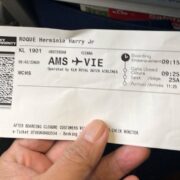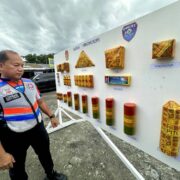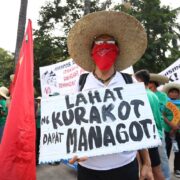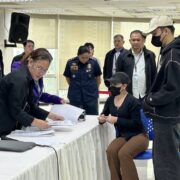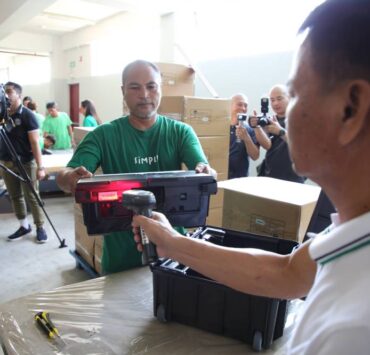2 PH ships, 40 Chinese vessels onboard resupply mission to Escoda Shoal
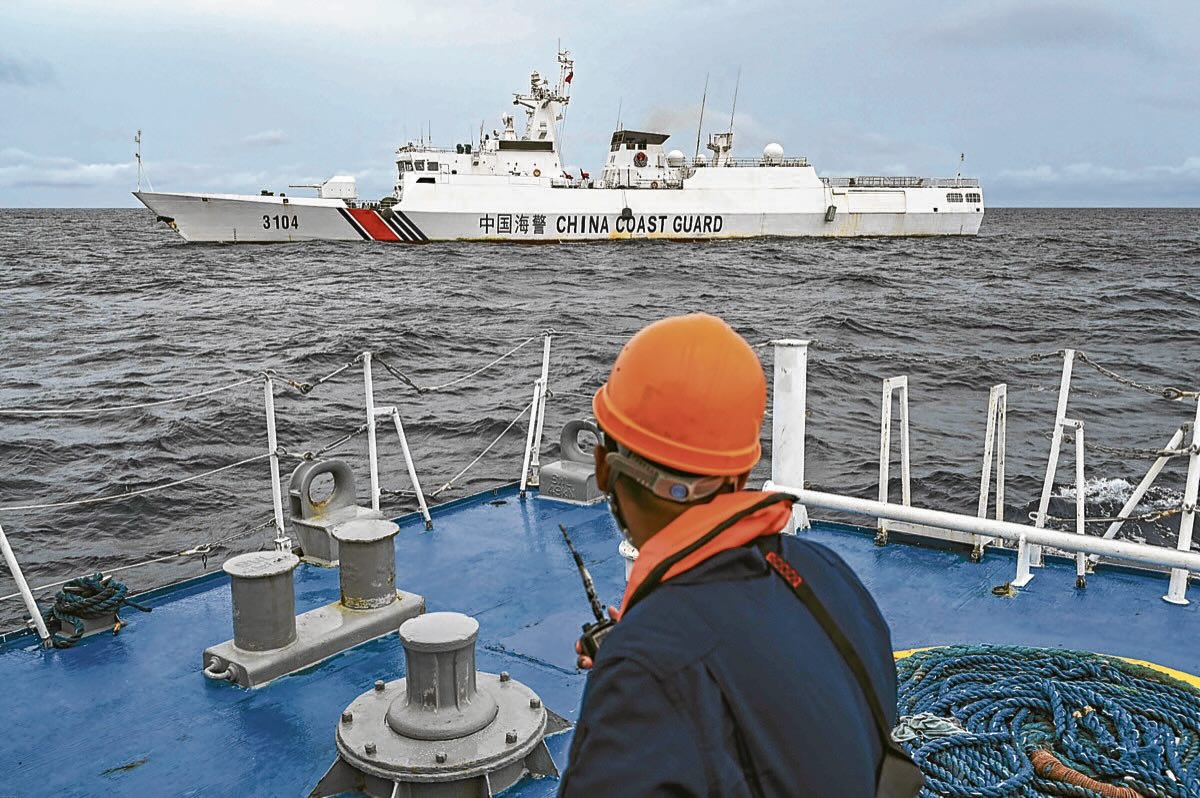
ABOARD THE BRP CABRA, WEST PHILIPPINE SEA—Just over 55 kilometers (30 nautical miles) away from the nearest Philippine shore off Palawan on Aug. 26, a 12,000-ton People’s Liberation Army (PLA) Navy Type 055 guided-missile destroyer with bow No. 105 was closely tailing a pair of much smaller Philippine Coast Guard (PCG) ships.
Over the next two hours, more Chinese coast guard and navy ships appeared over the horizon to deter BRP Cabra and BRP Cape Engaño, which were on their way to resupply another PCG vessel, BRP Teresa Magbanua (MRRV-9701), which had been deployed at Escoda (Sabina) Shoal since April in response to the continued presence of Chinese vessels and suspected reclamation activities in the area.
“This is China warship, we are taking measures to control Philippine Coast Guard ship 9701, which is illegally staying in Xianbin Jiao. You will not be allowed to enter Xianbin Jiao to carry out any replenishments,” the PLA navy ship told Filipino sailors over the radio, referring to the shoal by its Chinese name.
Although still more than 37 km (20 nautical miles) away from the shoal, we were already surrounded in all directions by six China Coast Guard (CCG) vessels supported by three PLA Navy ships. The embedded journalists on board the PCG ships, including myself, got our work gear ready while crew members made sure we were wearing life vests for our own safety.
We had watched the same scene play out before during resupply missions to Ayungin (Second Thomas) Shoal. Bringing supplies to troops stationed on BRP Sierra Madre, an active Philippine Navy vessel deliberately grounded on the shoal in 1999 to serve as the country’s outpost there, is frequently met with Chinese harassment. In July, both sides agreed on a “provisional arrangement” to de-escalate the situation.
Different situation
But this time, it was different and more worrying. Chinese vessels were moving in closer to our mainland, shrinking the maneuvering space within our own backyard.
Escoda Shoal, a low-tide elevation that lies some 139 km (75 nautical miles) from Palawan and over 1,111 km (600 nautical miles) from China, is well within the Philippines’ exclusive economic zone (EEZ). It also serves as the meetup point for PCG and Philippine Navy vessels conducting resupply missions to Ayungin.
The BRP Teresa Magbanua has been anchored inside the shoal since April to prevent Beijing from taking over the area. On National Heroes Day which had been declared a holiday, BRP Cabra and BRP Cape Engaño left Buliluyan Port in Palawan before daylight and sailed through choppy waters in monsoon weather.
The seas were expected to worsen in the coming days and it was deemed that this was the best time to leave for the “humanitarian mission.” The two smaller PCG ships were carrying fresh supplies, including ice cream, a special treat for the crew of BRP Teresa Magbanua
Just a day before, Chinese vessels had rammed and pummeled a Bureau of Fisheries
and Aquatic Resources ship with water cannons to disrupt a similar mission in Escoda, now rapidly emerging as a new flash point in the maritime dispute between Manila and Beijing. Days prior, a similar incident also took place in the area, but the Philippine ships were headed elsewhere at the time.
‘Excessive force’
From our viewpoint, there were around nine Chinese vessels blocking our path but the PCG later said there were more Chinese militia vessels located closer to the shoal. In total, an “excessive force” of 40 Chinese vessels had been deployed to stop the Philippine mission. And judging from recent confrontations, there was no way for us to get to our destination unscathed.
For five hours, we were stuck in place. At times, a CCG vessel would try to move closer, forcing us to move to keep a safe distance between their ship and ours. BRP Cabra then launched a drone to survey the Chinese vessels but later
lost control of it. The PCG suspected that a nearby CCG ship had jammed the signal because during a previous deployment, the same vessel was observed to be operating an alleged counter-drone gun.
At past 4 p.m., a crew member told me, “We’re going home. They won’t let us in. It’s about to get dark and the seas are starting to get more rough.” As the Philippine ships were steaming fast, I observed that we were still being followed by Chinese vessels nearby.
The encounter left me wondering what future missions to the shoal would be like as this was the first time the PCG failed to deliver supplies to BRP Teresa Magbanua.
China’s warning
Two days later, the PCG airdropped the supplies using its helicopter. China, which was first to announce the operation, called on the Philippines “to immediately stop its adventurous behavior and sensationalism, immediately withdraw the ship on its own, and not to misjudge the situation or escalate the situation.”
On Aug. 31, a CCG ship “intentionally and repeatedly” rammed the BRP Teresa Magbanua as it lifted anchor “with the intention of loitering” around the shoal, Philippine officials said. No one on board the PCG vessel was injured although the ship sustained some damage.
China claims nearly the entire South China Sea, overlapping its claims with those of the Philippines, Vietnam, Brunei, Malaysia and Taiwan. It also continues to ignore the 2016 arbitral ruling that invalidated its sweeping claims.
“Theoretically, only a mutually acceptable agreement between the two sides can turn the situation around at Escoda. However, the problem is that China does not have a track record of good faith when it comes to the South China Sea,” maritime security expert Jay Batongbacal of the University of the Philippines Institute for Maritime Affairs and Law of the Sea told the Inquirer.
According to him, Escoda is strategically important because it has access to Ayungin from north or south of Palawan. Ayungin, he said, lies between Escoda and the Chinese-occupied Panganiban (Mischief) Reef—a feature within the Philippines’ EEZ that Beijing seized in 1995.
Strategically vital
“Control of Escoda is one element of China’s attempt to absolutely control all seaborne activities in the South China Sea, and enable it to constrain Philippine access not only to Ayungin but eventually all Kalayaan islands currently occupied by the Philippines,” Batongbacal said.
Rommel Jude Ong, a retired Navy rear admiral and a professor of praxis at the Ateneo School of Government, said that China would take over Escoda should the Philippines show signs of yielding.
“Going by prior experience in Scarborough (Panatag) Shoal and Sandy Cay, once we have shown our interest in a specific feature and back down in the end, China will definitely take over,” he said. “If BRP Teresa Magbanua departs, China will take over and throw a defensive layer around it in the near term, and probably reclaim it and put up a facility as we have feared all along,” he added.
The Philippines, Ong said, should gamble on finding a suitable response against China’s tactics to protect its interests.
“China enjoys escalation dominance, and it doesn’t help that we have maintained a risk-averse posture. China will always try to escalate short of going kinetic, to compel the government to give up even on matters that are considered vital to national interest,” he stressed.
“While it is easier said than done, the government needs to find that sweet spot in terms of response, in which it is willing to take a calculated risk to stop China from further gaining a foothold inside our EEZ,” he added.
For now, the BRP Teresa Magbanua will stay at the shoal despite the damage it sustained, according to the National Maritime Council. “The Philippines will continue its sovereign operations in its maritime zones. The BRP Teresa Magbanua will remain and maintain its operations in the West Philippine Sea. We will not succumb to acts of harassment and aggressive behavior,” it said.






